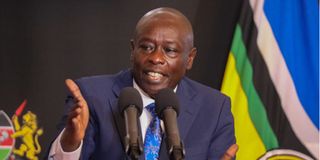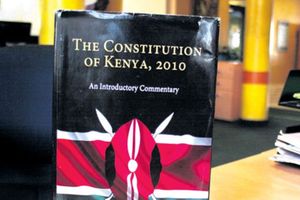
Deputy President Rigathi Gachagua addresses the media at his official residence in Karen, Nairobi, on October 7, 2024.
On October 8, 2024, Kenya’s National Assembly voted 282-44 to remove Deputy President Rigathi Gachagua from office, by impeachment. Accused of corruption, insubordination, undermining the government and divisive ethnic politics, the Gachagua persona has turned a sharp spotlight on the tale of three tribes — Kikuyu, Kalenjin and Luo.
Gachagua’s exit adds a new twist to the epic tale of three ‘ethnic aristocracies’, the heirs to the Happy Valley. Here, a Kenyan white aristocracy, a group of hedonistic, mainly British and Anglo-Irish aristocrats and adventurers reigned supreme until the 1940s when their fortunes fell. But the Happy Valley set left behind a deep legacy of a decadent lifestyle, insatiable craving for land, wealth and power that has since driven Kenyan politics.
From the ashes of the Happy Valley aristocracy, Kenya’s top ‘ethnic aristocracies’ quickly immortalised the ‘white mischief’ and the dangerous thirst for land, wealth and power. They are ‘aristocrats of the mind' who do not draw their wealth, power and prestige from their noble birth and holding hereditary titles and offices. Instead, they are an offshoot of the “empires of the mind,” which Winston Churchill believed would replace colonialism.
Corruption
In a tragic story of corruption, deceit and betrayal, Kenya’s three main ‘ethnic aristocracies’ have become adept at cobbling and dismantling ethnic alliances to win and control the state in an unending battle for land, wealth and power. Gachagua’s exit is a chapter in this continuing tragic ‘tale of three tribes’.
Gachagua’s impeachment comes hard on the heels of the collapse of the alliance between former President Uhuru Kenyatta’s Jubilee Party and Raila Odinga’s ODM at the core of the Azimio opposition.
This was a coalition of Kikuyu-Luo ethnic aristocracies and allied elite, which has gone through five reincarnations over the last six decades.
First, was the alliance of Kikuyu and Luo ethnic aristocrats forged on the anvil of nationalist consensus, which won the 1963 election and ushered Kenya into independence. Sadly, ideological differences between Jomo Kenyatta and Jaramogi Oginga Odinga over policies on land and other commanding heights of the economy fueled by Cold War geopolitics, and the assassination of Tom Mboya led to the collapse of Kenya’s first ethnic coalition, and left behind a smoldering ethnic animosity.
Although the politics of pro-democracy movement in 1988-1992 gave a new lease of life to the Luo-Kikuyu détente, it fell to a fierce rivalry between Jaramogi Odinga and Kenneth Matiba.
A third reincarnation of the Kikuyu-Luo détente came in 2002, with Raila Odinga’s famous ‘Kibaki Tosha’ clarion call. But failure to create an office of Prime Minister for Raila ended this short-lived alliance. The two former ethnic allies fought it out in the 2005 banana-orange Constitution Referendum and the 2007 elections. Briefly, the Grand Coalition government of Mwai Kibaki and Raila Odinga in 2008-2013 hiatus gave rise to the new Constitution.
Again, in March 2018, Kenyatta entered into an informal pact, the famous “handshake”, with Raila Odinga amid growing conflict with his deputy William Ruto. Arguably, the pact was a pre-emptive move to prevent an alliance between Odinga and Ruto, which would have made the president vulnerable to impeachment.
The 2022 election witnessed a rebellion by the Mount Kenya voters against their ethnic aristocracy. They voted for Ruto almost to a man. The 2022 election saw the return of the Kikuyu-Kalenjin détente. But Mount Kenya entered the Kenya Kwanza without a party, and with pact with the Kalenjin aristocrats. The Uhuru-Raila alliance ended in July 2024, when Odinga joined Ruto’s broad-based government. This spelt doom for Gachagua. The question still remains as to whether the Gachagua impeachment marks the end of the uneasy Kikuyu-Kalenjin detente that started in 2013.
The rivalry between the Kalenjin and Kikuyu ethnic aristocracies, which have dominated state power, has been more fundamentally about land (in the former White highlands), wealth and power. It all started in 1967, when Kenyatta appointed Daniel Moi as his Deputy President with Kikuyu as patrons and Kalenjin as clients. This role reversed when Moi took over as president when Kenyatta died in 1978. Moi appointed two Kikuyu deputies — Mwai Kibaki (1978-1988) and Prof Josephat Karanja as fifth Vice-President (1988-1989) — and George Saitoti (1989-2002). Constitutionally barred from seeking a third term, Moi handpicked Uhuru Kenyatta as his successor, who lost to Mwai Kibaki.
The Kalenjin ethnic aristocracy has always formed political alliance with the Luo to counter Kikuyu power. The return of the Kalenjin-Luo détente in the broad-based Government made Gachagua’s impeachment possible.
Like the Kalenjin-Kikuyu alliance, the Kalenjin-Luo political détente has had its own reincarnations. After the December 29, 1992 General elections, Moi courted Jaramogi Odinga’s ‘cooperation’ to counter the Kikuyu force led by Kenneth Matiba and Mwai Kibaki in Parliament. This was the origin of the ‘Ji-Alliance’, an informal Nilotic cooperation.
This cooperation deepened after 1997 elections when Odinga’s heir, Raila Odinga, formally joined Kanu in a ‘cooperation’ with Moi. This ended in 2002 when Moi named Uhuru Kenyatta as his successor.
The Kalenjin-Luo détente took a new turn during the constitutional Referendum in the 2005 and more increasingly in the 2007 election, which Kibaki narrowly won. The Kalenjin overwhelmingly backed Raila Odinga, who they fondly called “arap Mibey.” The broad-based government after July 2024 is by and large a Luo-Kalenjin alliance. Without it, Gachagua could have survived impeachment.
As Gachagua exits, Mount Kenya is in disarray and in need of a party and a community leader. Both Kenyatta and Gachagua failed to win the hearts and minds of lawmakers, and lost. The Kalenjin-Luo ethnic aristocracies are closing in on the region, in a divide-and-conquer fashion. The future looks bleak. Is the curtain falling on the once powerful Mount Kenya ethnic aristocracy? Or is this the end of the tale of the three tribes, and the rise of the rest?
Professor Peter Kagwanja is Chief Executive at the Africa Policy Institute and Adjunct Scholar at the University of Nairobi and the National Defence University, Kenya.













